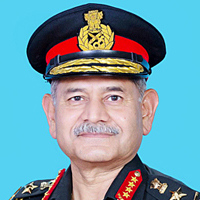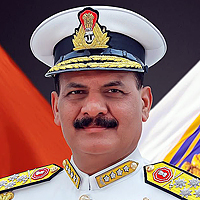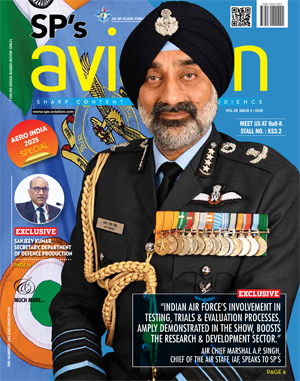INDIAN ARMED FORCES CHIEFS ON OUR RELENTLESS AND FOCUSED PUBLISHING EFFORTS

The insightful articles, inspiring narrations and analytical perspectives presented by the Editorial Team, establish an alluring connect with the reader. My compliments and best wishes to SP Guide Publications.

"Over the past 60 years, the growth of SP Guide Publications has mirrored the rising stature of Indian Navy. Its well-researched and informative magazines on Defence and Aerospace sector have served to shape an educated opinion of our military personnel, policy makers and the public alike. I wish SP's Publication team continued success, fair winds and following seas in all future endeavour!"

Since, its inception in 1964, SP Guide Publications has consistently demonstrated commitment to high-quality journalism in the aerospace and defence sectors, earning a well-deserved reputation as Asia's largest media house in this domain. I wish SP Guide Publications continued success in its pursuit of excellence.
Maccready Gossamer Albatross: Pedal-Powered Flight
The surface headwind calmed slightly and the coast of Cap Gris-Nez, France, finally came in sight. Allen made a successful landing, completing the 35.7 km flight in 2 hours and 49 minutes. And the MacCready team took home the prize.

The Gossamer Albatross was a human-powered aircraft (HPA) built by American aeronautical engineer Paul MacCready’s company AeroVironment. It was not intended as a practical plane for production. Nonetheless, it harnessed the ultimate in human ingenuity and engineering excellence available at the time. An HPA is usually propelled forward by a lone pilot vigorously pumping a pair of pedals connected to a propeller through a simple gears-and-chain arrangement. The pilot both steers and powers the aircraft. Given the sheer amount of power required to keep even a very light plane aloft for any length of time, even a strong cyclist would find it challenging and exhausting to fly in this manner. Yet, in June 1979, the Gossamer Albatross successfully crossed the English Channel, establishing a world record that still stands today.
Dr Paul MacCready (1925-2007) was a noted aeronautical designer and a world soaring champion. His first HPA was the Gossamer Condor which won the first Kremer prize on August 23, 1977, by completing a 1.6 km ‘figure of eight’ course. Incidentally this prize had been announced in 1959 but had gone unclaimed for nearly two decades. Thereafter the second Kremer challenge was announced as a flight across the English Channel to commemorate Louis Blériot’s epic aerial crossing of 1909. MacCready immediately set up an expert team that designed and built the Gossamer Albatross in record time. The main differences between the Condor and the Albatross were a reduced wing area and shorter wing chord on the Albatross, along with a change from an aluminium main structure to carbon fibre-reinforced plastics. The Albatross was of canard configuration, with a large horizontal stabilizer forward of the wing, somewhat similar to the Wright brothers’ successful Wright Flyer aircraft. The wing ribs were made of expanded polystyrene. The entire structure was then covered with thin transparent plastic sheeting developed by DuPont. It had very long and thin tapered wings (high aspect ratio) like those of a glider. With a length of 10.36 m, wingspan of 29.77 m, and height of 4.88 m, the aircraft’s wing area was 45.3 square metres. And yet the empty mass of this huge structure, comparable with a super mid-sized business jet, was just 32 kg – in itself an amazing feat of engineering. Indeed, construction of the innovative plane, and organising the Channel crossing attempt, cost far more than the prize money on offer. But seeing as it would help promote their own products, DuPont agreed to partly fund the expedition.
Test flights began in the summer of 1978, first at Shafter airport in California, then near the ocean at Long Beach. The Albatross was flown and powered by amateur cyclist Bryan Allen, seated in a clear plastic enclosure. The team knew that a Channel crossing would be an extreme athletic feat requiring the pilot to pedal hard for a lengthy period without rest. As an experienced long-distance cyclist, Allen was an excellent choice. He trained both on the road and with an ergometer (a stationary training bicycle). He finally pedalled the Albatross through a 21-km, 69-min flight over Harper Lake in April 1979. The aircraft’s maximum speed was 29 km/h and design range was 56 km – more than enough for the Channel crossing.
Just before 6 am on June 12, 1979, the Channel conditions and lack of wind seemed favourable for the exhausting flight ahead. Allen pedalled the Albatross to the required speed of 75 rpm and took off from a makeshift runway near Folkestone, England. His troubles began soon afterwards. The radio failed for a while and he was only able to communicate with the accompanying boats by hand and head movements. Later he experienced strong headwinds, extending the planned flight. His water supply, just enough for a two-hour flight, ran out. Consequently, he suffered from dehydration and leg cramps. Again due to the extended flight, the airspeed instruments and acoustic altimeter failed when their batteries expired. So Allen had to visually assess his speed, and height above the water. Hence, preparations began to abort the flight, and the rescue boat began manoeuvring to hook the aircraft to safety.
However, when Allen climbed slightly to allow the boat to approach underneath, he found the air less turbulent. He requested another five minutes, then another five minutes, and then another five. The surface headwind calmed slightly and the coast of Cap Gris-Nez, France, finally came in sight. Bryan Allen made a successful landing, completing the 35.7 km flight in 2 hours and 49 minutes, with a max speed of 29 km/h and an average altitude of 1.5 m. And the MacCready team took home the prize of £1,00,000.
Paul MacCready was later awarded the Collier Trophy for the foremost achievement in aeronautics for 1977. He went on to help design and build several more record-breaking human- and solar-powered aircraft.





